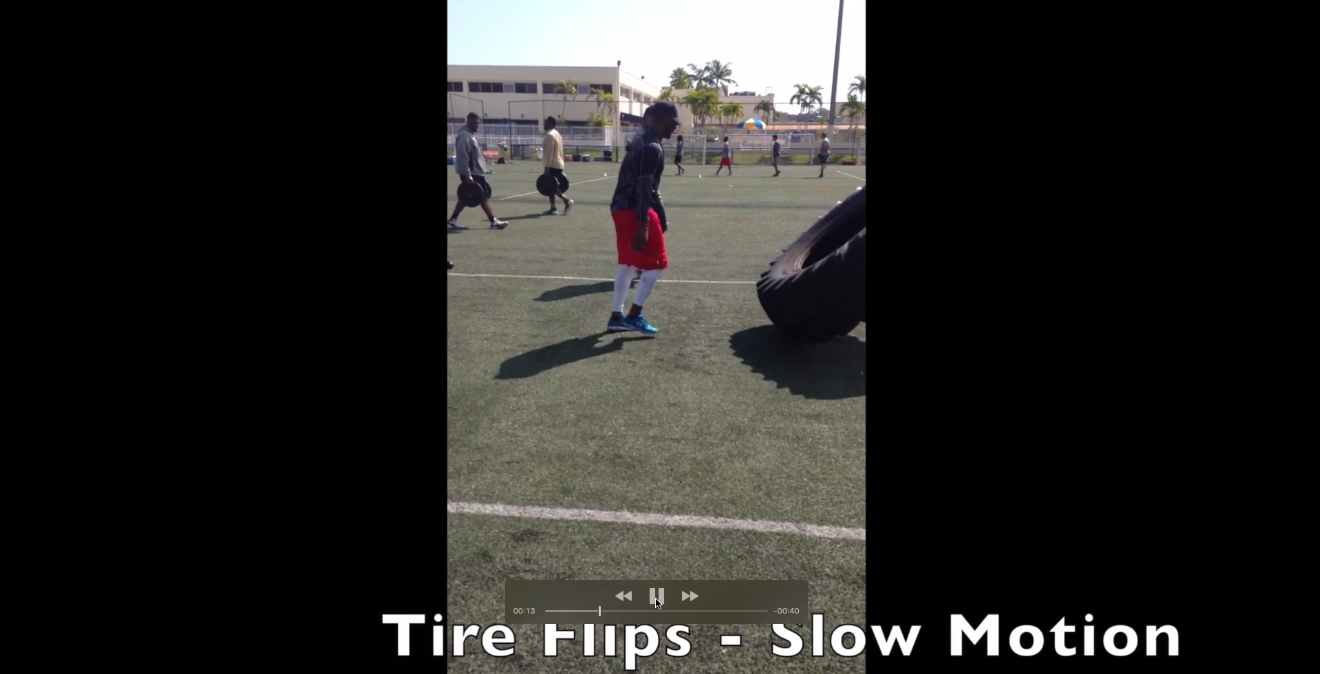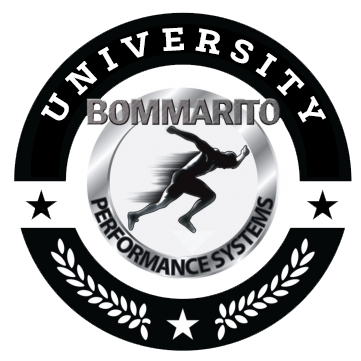This variation of lateral med ball slams is all about stability. There are many different factors here that are at play within this rather simple looking exercise. Stability is all about the isometrics. This dynamic lateral mb slam isometrically loads the trunk/spine extensors and lateral flexors. Also, pay attention to the alignment of the feet. The use of a low split-stance causes the adductors to stay active, therefore stabilizing the SI Joint. We are also set up in an “unsupported” stance. This means that the knee is off the ground. By doing this unsupported, we are able to overload the challenge at the toe, foot, ankle, and knee joints. All in all, the whole body is being isometrically stabilized throughout this movement. Try it out and let us know what you think!
Developing Power Base
Pool Deceleration Work
The art and success of changing directions efficiently in any sport is significantly dependent on the DYNAMIC ECCENTRIC load of the posterior chain. And this load needs to be trained at the Support System chain and the Suspension System chain leading into the trunk.
The base is obviously built in the weight room. But there needs to be a transfer to the field. Hence, the DYNAMIC eccentrics – with all angles and diverging forces. And transferred into all aspects of the stretch-reflex (note the vertical, lateral, and horizontal plyometrics).
Note the forces demonstrated here – vertical to lateral; lateral to vertical; double leg; single leg; lateral to lateral; fwd angle; back angle; 90-deg and 180-deg diverging force; and all AGGRESSIVE horizontal (straight leg rhythms, and the incorporation of the accel bounding).
While this work is absolutely necessary, it’s aggressive. This is why it’s so effective in the pool. The muscle action is high so the Vinnie can be high. But, there is less pounding on the joints. In addition, there is an added effect of lateral power and knee extensor power and hip extensor power driving through the water resistance. Further, note the added challenge of stabilization on some of the diverging force landings – because of the momentum caused by the water.
Band Jammer
Rotational Power – Variable Load
The Rotational Band Jammer, low position, back foot rotate. This version focuses on hip internal rotation power initiating the trunk rotation power. The heavy band resistance allows to accelerate through the end range of motion.
Band Jammer
Explosive Split Cycle Plyometrics
Explosive Split Cycle Plyometrics
The Keys:
1. Knee Punch out of the water. Taking the back leg from the down lunge position, fully drive through the water resistance in to max hip flexion.
2. Split in to a deep lunge (back knee about 2 inches off the ground), while keeping the trunk tight so from the shoulder to the knee is a straight line.
3. Arm action!
Box Jump Series
Lateral Box Jump Series
Tire Lower Power
Tire Flips
Keiser/Band Power – Lower
Coaching Video – Keiser Jump Series
Loaded Jumps
Unloaded/Light Loaded Vertical Power
In this video you will see the science and concepts of Vertical Power:
- Overview: Approach the basic concept of building pure power development in a weight room setting; primarily in the vertical aspect. The scientific concepts of the stretch reflex, the crossed-extensor reflex, maximizing concentric power while minimizing joint loading.
- Exercise Sequence: with full demonstrations and explanations and coaching cues
-
- Box Jump – Power, Stretch Reflex, Coordination, minimizing joint loading
- Seated Box Jump – same as Box Jump, with more emphasis pure concentric power and less on the stretch reflex
- Seated Depth Jump – same as Seated Box Jump, except a little more emphasis on the stretch reflex
- Weighted Box Jump
- Weighted Seated Box Jump
- Weighted Seated Depth Jump
-
Resisted and Loaded Vertical Plyometrics
In this video you will see Resisted and Loaded Vertical Plyometrics:
- Overview. The progressive intensity of the Vertical Plyometric concepts with variations of single leg action, various weighted exercises with in increased emphasis on high speed eccentric loading with the landing options
- Exercise Sequence:
-
- Bulgarian Squat Jump
-
- 11X Tempo
- 10X Tempo
-
- Bulgarian Squat Jump
-
Landmine Jammer Series
Landmine Linear Jammer
Band Jammer Series
Band Jammer / LM Jammer Overview
In this video you will see Resisted & Loaded Horizontal Power:
- Band Jammer
- Landmine Linear Jammer
Band Jammer
Olympic Lifts
Olympic Lifting Partials – Overview
Olympic Lifting Partials – Overview
In this section you will see the Science/Concepts/Overview of certain Lifts/Pulls related to Vertical Power:
Olympic Lifts/Pulls: Clean Pull Mid Thigh/Below Knee/Floor & Snatch Pull Mid Thigh/Below Knee/Floor
Olympic Lifts/Pulls with Variable Load: Deadlift/Clean Pull with Band Resistance
Handled MB RNT
MB RNT
Tire Upper Power Endurance
Tunch Punch Power Endurance
Keiser/Band Power Endurance
MB Power
Lateral Plyometrics
Coaching Video – Single Ladder Linear
Horizontal Plyometrics
Horizontal Plyometrics – Overview
The scientific concepts and application of the broad category of Long Response Plyometrics. Introduction of key concepts of these types of plyometric exercises: stored elastic energy (specifically in the Gastro-Soleus complex), leading into success of the stretch reflex across this joint (which IS a trainable effect), and the crossed-extensor reflex that will subconsciously occur as the legs action efficiency will be dictated by the efficiency of the arm action (hence, the arms lead the legs).
The Long Response Plyometrics, contrasted to the Vertical Plyometrics in the Vertical Plyometric section, is now featured with the emphasis of:
- Shorter ground contact
- More specific
- Rate of force development
The progressive exercise sequence of overloading these concepts with an Acceleration emphasis with a piston-like action or the Absolute Speed cyclical motion:
- Acceleration Bound
-
- Low/Medium/Full Height
-
- Absolute Speed Bound
-
- Double leg jump
- Double leg skip
- Double leg bound
- Single leg alternating
-
CV – Tuff Tread Acceleration Bound Series FULL
OVERSPEED LIGHT PULLEY MACHINE SETUP INSTRUCTIONS
Single Leg Vertical Plyo
SL Vertical Plyo – Basic
In this video you will see a continuation of Vertical Plyometrics with Single Leg Variations:
- Overview. Approach to the physiological adaptation of the Vertical Plyometric Series – Jumps, Skips, and Depth Jumps; but now on ONE LEG in various angles and introduction of power on the edges of the feet.
- Exercise Database Sequence:
-
- SL Linear
- SL Lateral (Inside Edge & Outside Edge)
- SL Multidirectional
-
Hockey Plyometrics
Box Vertical Plyo – Lateral to Crossover; Same Side; Plyo Continous
Power Skating Plyo Series- Advanced
We’ve transitioned from the deceleration and isometric emphasis; into higher loads of reflexive plyometrics. Note the example of the Lateral position to the X-Over position, full Plyo bound, max height (opposite side). Emphasizing the “nose / knee / foot” alignment consistent with all speed skating dry land movement patterns. This is a really good demo for the consistency of the position (especially on the X-Over positions – see the angle of hip horizontal adduction).
Finally, addition of a diverging force adds different stimuli. Here it’s a back Raptor load at the waste. We executed successive sets with lateral and front forces.
Box Vert Plyo – Break Down
Box Vert Plyo – Break Down PT 2
DL Vertical Plyo
DL Jump/Skip Overview
In this video, you will learn/see:
Understanding the two main broad categories of Plyometrics and their components:
- Long Response Plyometrics – basic, less specific, longer ground contact, emphasis more on pure power production
- Short Response Plyometrics – advanced, more specific, shorter ground contact, emphasis more on rate of force development
Approach to the science aspects of the Long Response Plyometrics, and how this very specific form of a stretch reflex can set the base of general power; primarily in the vertical aspect.
Beginning of the database of the Vertical Plyometrics
- Jumps – arm/hips coordination and synchronization; along with pure power production, high speed eccentric loading, and subsequent deceleration into isometric contraction emphasis around the hips, knees, and ankles
- Skips – similar physiological adaptation of the Jumps, except now with a series of low-grade plyometric rhythmic hops in between main plyometric actions; ground contact of this main plyometric action is obviously much less that the Jump
DL Depth Jump Series
In this video, you will learn/see:
Scientific breakdown of the culmination of the Vertical Plyometric Series – the Depth Jump.
The ultimate drill in developing the general Power base while still achieving a good emphasis on rate of force development
The important “bridge” in getting the power adaptation necessary for success in the more specific Short Response Plyometrics
Approach to the physiological adaptation of the Vertical Plyometric Series – Jumps, Skips, and Depth Jumps; but now in various angles and introduction of power on the edges of the feet:
Linear
Lateral
Multidirectional
Tire Flips


